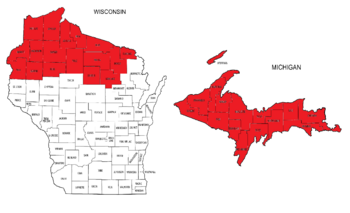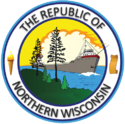Superior
This article is incomplete because it is pending further input from participants, or it is a work-in-progress by one author. Please comment on this article's talk page to share your input, comments and questions. Note: To contribute to this article, you may need to seek help from the author(s) of this page. |
Republic of Northern Wisconsin | |
|---|---|
|
Flag | |
| Motto: Our right, our land! | |
 | |
| Capital | Iron Mountain |
| Largest city | Superior |
| Official languages | English |
| Demonym(s) | Wisconsinite |
| Government | Provisional Presidential Republic |
• Provisional President | Wayne Arthur Kirkham |
• Provisional Deputy-President | Edwin Mills |
| Legislature | Provisional State Council |
| Independence from United State of America | |
| Area | |
• Total | 35,841 sq mi (92,830 km2) |
| Population | |
• 2020 estimate estimate | 661,807 |
• Density | 18.4/sq mi (7.1/km2) |
| Currency | Northern Wisconsin Dollar |
| Time zone | CST |
| Date format | dd-mm-yyyy |
| Driving side | right |
| Internet TLD | .nw |
Northern Wisconsin officially the Republic of Northern Wisconsin is a self-proclaimed breakaway state in midwestern United States. It lies between the states of Minnesota, Wisconsin and Lake Superior, occupying an area of 92,830 km2 (35,841 sq mi), with a population of about 661,000. Northern Wisconsin declared its independence from the United States in March of 2021 and has since gained no diplomatic recognition as a sovereign state. Most of Northern Wisconsin is covered in a mixture of plains and fields and dense forests. Its capital is Iron Mountain and largest city is Superior.
History
The idea of the republic originated from a little known man named Wayne Arthur Kirkham. Kirkham called himself a localist and a supporter of home rule for individual counties. He believed that counties should have the right to decide what state it belongs to or whether it belongs to a state at all, and that the eastern federal governments are out of touch, slow to respond, and hinder state and county attempts at further bioregional integration. Kirkham was elected to the Iron County Board of Supervisors, where he mostly gained popularity because of his localist rhetoric, which to most people was seen as just being extremely devoted to the community. After several months on the board, a course of events and shuffling of roles within the Iron County Board of Supervisors led to Kirkham being appointed Vice-Chairman. Through his position, he continued to work and advance his agenda, supporting more independent and self-ruling policies whenever possible. By the next election cycle, Kirkham had been made Chairman and started to pick up supporters from other surrounding counties. A few members of nearby county boards had adopted Kirkham ideas and aligned themselves as allies, which Kirkham accepted and worked to support them whenever possible. Kirkham had established the "Northern Wisconsin Independence Front" or NWIF for short, as to give his movement a label. After just two years, the counties of Iron, Vilas and Ashland in Wisconsin and Gogebic, Iron and Ontonagon in the Michigan Upper Peninsula had county boards with known members of the NWIF, or supporters/collaborators therein.
Kirkham continued to retain his position on the Iron County Board of Supervisors, but by this point his position became much more important. As Chairman of the NWIF, he was responsible for aiding and assisting his allies in positions of power across other local governments down to the village level. Kirkham worked to get supportive sheriffs and judges elected in surrounding counties and funded new candidate campaigns in other counties through money given from donations. The rise of racial unrest and woke culture in the United States further accelerated support for the NWIF, as many people living in northern Wisconsin wanted to disassociate with what was going on in the rest of the nation and support conservatism and traditionalim. Kirkham worked with local law enforcement agencies to clear up the rules behind forming local militias, a very important step for the NWIF and its member counties to become somewhat militarily independent from the state. The creation of local militias was approved by members of the NWIF and was implimented to member counties. County sheriffs and deputies supervised and trained the militias, which aided in providing law enforcement and security to local businesses in times of potential rioting and looting.
By the next election cycle, the number of counties and/or county boards with supporters had doubled thanks to hectic events across the nation. Half of the counties in the Michigan upper peninsula were part of the NWIF, and 8 counties in Wisconsin had become members. The NWIF was growing at a shocking rate where most people in member counties identified with it rather than the Democratic or Republican parties. The NWIF was running a platform consisting of localism, nativism, anti-federal government, anti-woke culture, traditionalism, disunionism and national conservatism. By this time, Kirkham had given up his position on the Iron County Board of Supervisors to take up full-time duties as Chairman of the NWIF. This trend continued for two more local election cycles until the the NWIF had reached its height, at 17 member counties in Wisconsin (with Barron county being the last to join) and all 15 counties in the upper peninsula had become members.
Kirkham and the NWIF had hit a turning point for their future. Hardliners within the NWIF had stated that a referendum should be put in place within all member counties to declare themselves independent from their states and from the United States as a whole. Others in the NWIF worried that many members of the NWIF were not serious about seceding from the United States or were just localist to support their communities, and that people still felt too attached to their country. Kirkham worried that failing to take any action could have members abandon the NWIF. On June 5th, a meeting was called with at least one representative from all member counties of the NWIF being present. Kirkham proposed that all member counties issue a referendum selecting one choice from among the following three alternatives: 1) Remain part of current states. 2) Form a new state with member counties. 3) Become a separate and Independent Nation.
"If in fact we are our own country, well then, by god, we ought stand up and declare it. Even if they push us back in the forests, if we're willing to die for something, we sure as the devil oughta be able to say what it is out loud. We're not gonna listen to what some libtard lawmaker decides for us some 300 miles away from here. This is our land, this is our right! From this day forward, we should declare the land north of the '64 to Copper Harbor, south of Lake Superior and east of the Mississippi to the shores of Lake Michigan to be the Republic of Northern Wisconsin. We decide our own future now." -Wayne Arthur Kirkham
Geography
Politics
Military
Armed miltia groups and separatists are split into dozens of guerilla groups of various sizes, most of which are a part of the Northern Wisconsin State Defence Force under the provisional government. The state militia consists only of volunteer units. Provisional president Wayne Kirkham had created a legal framework for local militia companies to organize, drill, and serve as a home guard unit capable of handling state emergencies under the assistance and supervision of county sheriffs offices. Reports estimate that around 6,000 to 7,000 individuals are active militiamen, with a reserve force of 13,000 to 15,000. Most militiamen are stationed at strategic locations in Northern Wisconsin including (but not limited to) power plants, airports, harbors, police stations, courts, former Wisconsin National Guard armories, municipal buildings and newspaper and radio stations.
The Northern Wisconsin Naval Militia has around 500 volunteers. The Northern Wisconsin Civil Air Patrol handles the management and security of airfields in the republic.
